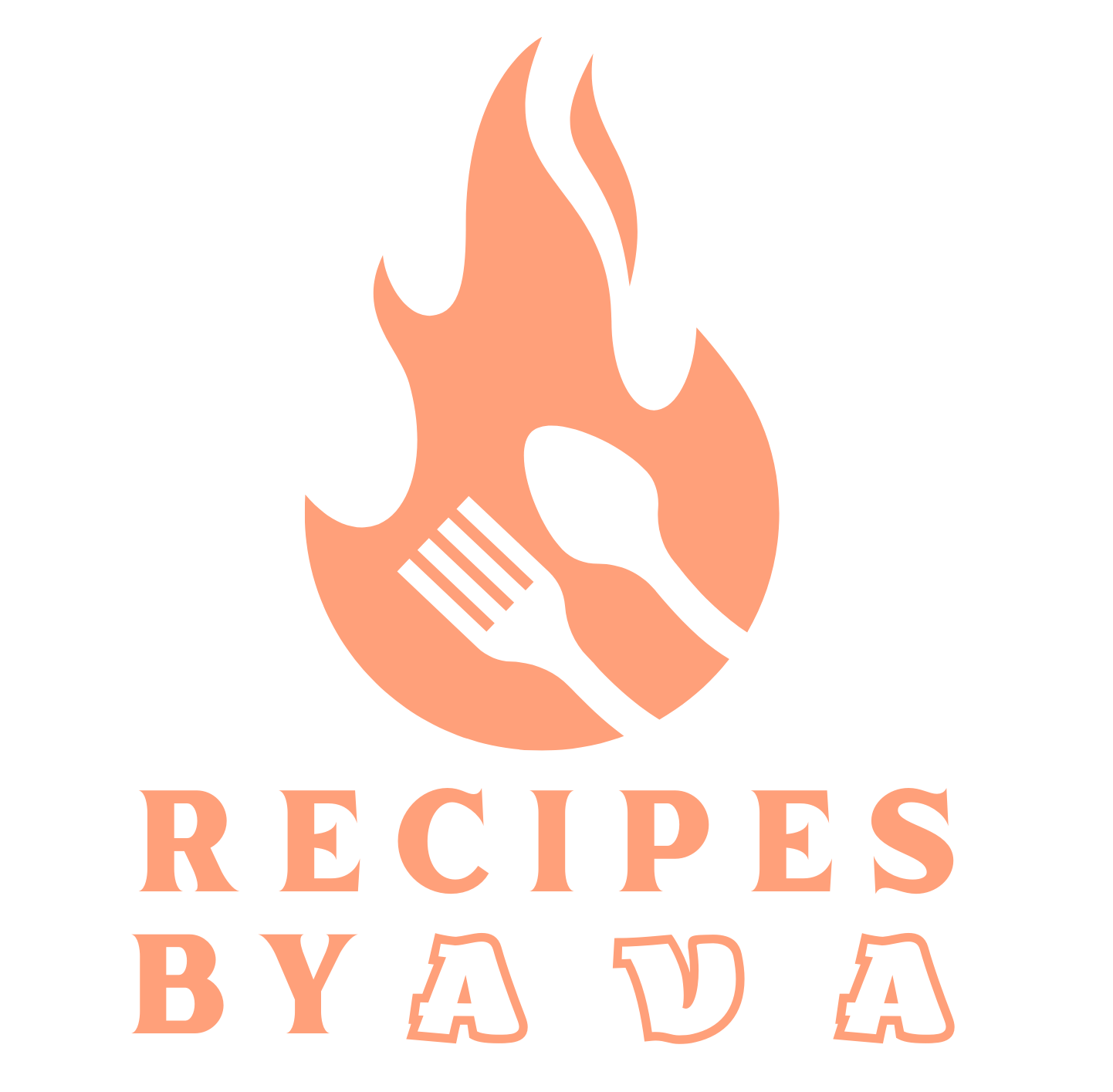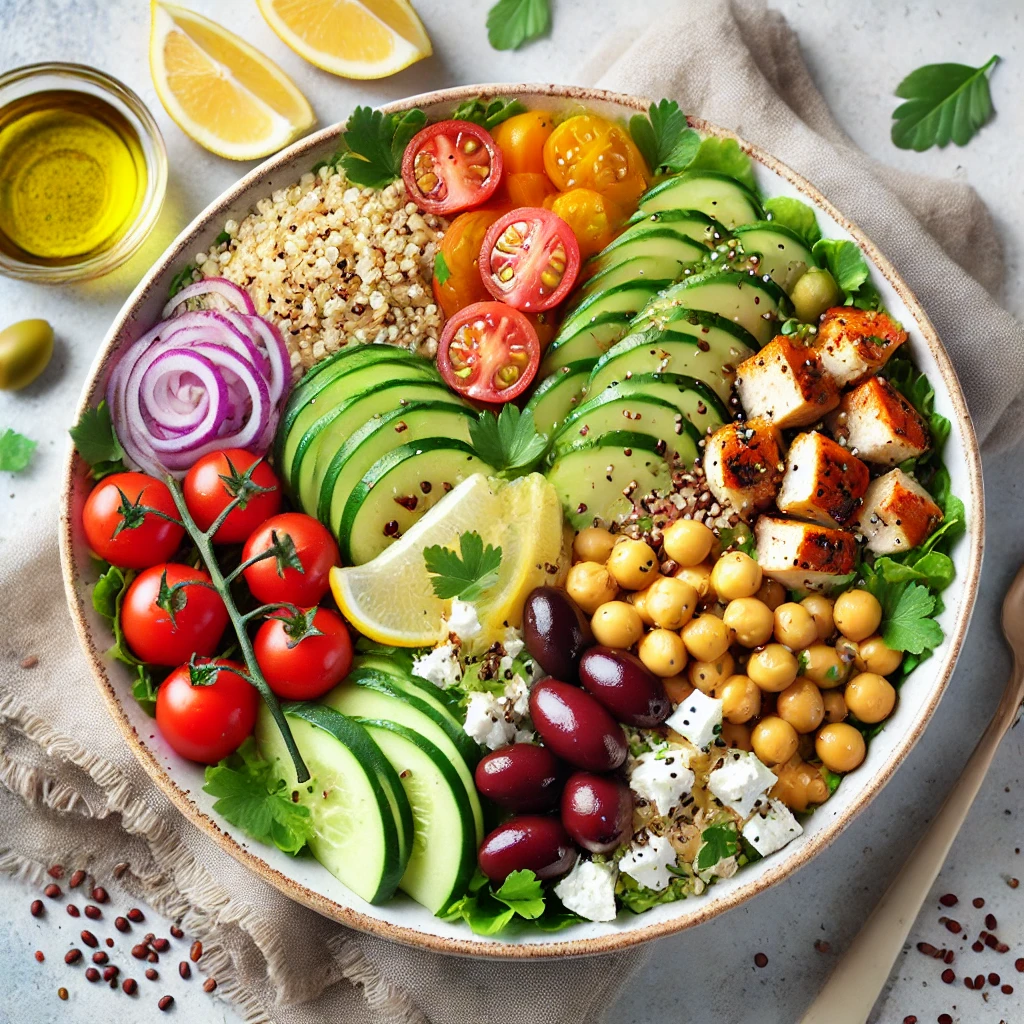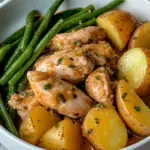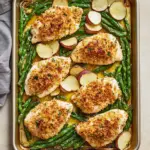When it comes to healthy eating, the Mediterranean diet is often regarded as one of the best options. Known for its heart-healthy fats, nutrient-rich vegetables, and whole grains, this diet provides the perfect balance of taste and nutrition. One of the most versatile and delicious ways to incorporate Mediterranean flavors into your diet is through a Mediterranean Grain Bowl. These bowls are not only packed with fiber, vitamins, and minerals, but they also make for a satisfying and flavorful meal that can be customized to your liking.
In this blog post, we’ll dive into what makes Mediterranean grain bowls so nutritious, why they’re perfect for meal prepping, and how you can make your very own Mediterranean Grain Bowl at home with a step-by-step guide. We’ll also discuss ingredient variations and provide helpful tips for ensuring your bowl is bursting with flavor while still being balanced. At the end, I’ll include a beautiful photo to inspire you to try it for yourself!
What is a Mediterranean Grain Bowl?
A Mediterranean grain bowl is essentially a deconstructed Mediterranean salad, served over a base of whole grains. This dish is often loaded with fresh vegetables, legumes, nuts, and healthy fats like olive oil and avocado. The grains provide a hearty foundation, while the rest of the ingredients supply flavor, texture, and nutrients.
Think of it as a Mediterranean “power bowl” where every component adds to your overall health. These bowls can be served hot or cold, making them a versatile choice for any meal of the day. Whether you’re looking for a nutrient-packed lunch or a light dinner, this dish is a go-to for anyone interested in clean eating.
Nutritional Benefits of Mediterranean Grain Bowls
Mediterranean grain bowls are not only tasty but also provide numerous health benefits. Here are some reasons why this dish is a great addition to any diet:
- Rich in Fiber: Whole grains like quinoa, farro, and bulgur are high in fiber, promoting digestive health and keeping you full for longer. Fiber is also known for stabilizing blood sugar levels and improving heart health.
- Loaded with Antioxidants: Vegetables, such as tomatoes, cucumbers, spinach, and olives, are rich in antioxidants, which help fight inflammation and protect against chronic diseases.
- High in Healthy Fats: Olive oil, nuts, and avocados are staple ingredients in Mediterranean cuisine and are full of monounsaturated fats, which can reduce bad cholesterol and support heart health.
- Protein-Packed: Chickpeas, lentils, and quinoa provide plant-based protein, making these bowls a perfect option for vegetarians and vegans. If you’re not plant-based, adding grilled chicken, shrimp, or salmon enhances the protein content even further.
- Vitamin Powerhouse: The vegetables, herbs, and spices used in a Mediterranean grain bowl are full of essential vitamins like vitamin C, K, A, and B-vitamins, which are necessary for various bodily functions, including immune support, skin health, and energy production.
Ingredients for a Classic Mediterranean Grain Bowl
One of the great things about Mediterranean grain bowls is how easily they can be customized to your preferences and dietary needs. However, some classic ingredients are commonly used to keep things authentic and nutrient-rich. Here are some key components you can include:
1. Grains:
- Quinoa: A gluten-free option, high in protein and essential amino acids.
- Farro: A chewy, nutty grain packed with fiber and nutrients.
- Bulgur: A quick-cooking whole grain made from cracked wheat.
- Brown Rice: Another gluten-free option with a more neutral flavor.
2. Vegetables:
- Cucumbers: Crisp and hydrating, perfect for adding crunch.
- Cherry Tomatoes: Sweet and juicy, packed with vitamin C and antioxidants.
- Red Onion: Adds a mild, spicy flavor with a good dose of vitamin C and fiber.
- Kalamata Olives: A Mediterranean staple, rich in healthy fats and antioxidants.
- Spinach or Arugula: A leafy green base for added texture and nutrients.
3. Proteins:
- Chickpeas: A plant-based protein rich in fiber and essential minerals.
- Grilled Chicken: A lean protein source that pairs well with Mediterranean spices like oregano and thyme.
- Grilled Shrimp or Salmon: Both are excellent sources of omega-3 fatty acids.
- Feta Cheese: Adds a salty, creamy texture and a bit of protein and calcium (optional for those who consume dairy).
4. Healthy Fats:
- Extra Virgin Olive Oil: A heart-healthy fat that is essential in Mediterranean cooking.
- Avocado: Creamy and packed with vitamins and minerals.
- Nuts and Seeds: Add texture and healthy fats with options like almonds, walnuts, or sunflower seeds.
5. Herbs and Seasonings:
- Fresh Parsley or Basil: Fresh herbs elevate the flavor and add a bright, refreshing taste.
- Garlic: A Mediterranean flavor enhancer that’s rich in antioxidants and anti-inflammatory properties.
- Lemon Juice: Adds acidity and brightness to balance the richness of olive oil and feta.
- Sumac or Za’atar: Mediterranean spices that add tangy and earthy notes to your bowl.
- Salt and Pepper: Basic seasonings that bring out the flavor in every ingredient.
Step-by-Step Guide to Building Your Mediterranean Grain Bowl
Now that you know what ingredients to use, let’s move on to the step-by-step process of building your perfect Mediterranean grain bowl:
Step 1: Cook Your Grains
Begin by cooking your grains according to package instructions. Quinoa, farro, and bulgur are all excellent options, but make sure to rinse them thoroughly before cooking. Once they are fully cooked, let the grains cool slightly if you prefer a cold bowl.
Step 2: Prep Your Veggies
While your grains are cooking, chop your vegetables. Slice cucumbers, halve cherry tomatoes, dice red onions, and chop fresh herbs like parsley and basil. You can also roast vegetables like zucchini, eggplant, or bell peppers for added depth and flavor.
Step 3: Prepare Your Protein
If you’re using chickpeas, drain and rinse them from the can. You can either add them as-is or roast them in the oven with some olive oil, paprika, and garlic powder for extra flavor. If you prefer animal protein, season your chicken, shrimp, or salmon with Mediterranean spices like oregano, garlic, and lemon before grilling or pan-searing.
Step 4: Assemble the Bowl
Start by adding a generous portion of your cooked grains to a large bowl. Then, top with your selection of vegetables, protein, and healthy fats. Drizzle extra virgin olive oil and fresh lemon juice over the top, and season with salt, pepper, and herbs. If you like spice, you can sprinkle a little red pepper flakes or add a dollop of harissa.
Step 5: Garnish and Serve
Finally, garnish your Mediterranean grain bowl with feta cheese (if using), chopped parsley or basil, and a handful of nuts or seeds for added crunch. Serve immediately, or pack it into a container for meal prepping.
Mediterranean Grain Bowl Variations
One of the best things about Mediterranean grain bowls is their versatility. Here are a few variations to keep things exciting:
- Vegan Mediterranean Grain Bowl: Skip the feta and meat, focusing on chickpeas, roasted vegetables, and a tahini-based dressing for added creaminess.
- Grilled Vegetable Grain Bowl: Roast or grill seasonal vegetables like zucchini, eggplant, and red bell peppers to add a smoky flavor.
- Seafood Grain Bowl: Swap the chicken for grilled shrimp or salmon for a fresh take on this dish, full of omega-3 fatty acids.
- Pesto Mediterranean Grain Bowl: Add a dollop of homemade or store-bought basil pesto to the top of your bowl for extra flavor.
- Greek-Inspired Grain Bowl: Include kalamata olives, tzatziki sauce, and a sprinkle of oregano for a more traditional Greek flavor.
Tips for Meal Prepping Mediterranean Grain Bowls
Mediterranean grain bowls are perfect for meal prepping because most ingredients can be made ahead of time. Cook your grains and proteins in bulk, chop your vegetables, and store everything separately in airtight containers. Assemble the bowls just before eating to keep everything fresh. The grains, protein, and vegetables will last up to 4 days in the fridge, making this an ideal meal prep option for busy weeks.
Conclusion
The Mediterranean Grain Bowl is a simple, delicious, and incredibly nutritious meal that can be customized to suit your tastes. By focusing on whole grains, fresh vegetables, and healthy fats, you’re not only indulging in a tasty meal but also nourishing your body. Whether you’re looking for a quick lunch or a meal-prepped dinner, the Mediterranean grain bowl is an easy go-to that never disappoints. Plus, it’s a dish you can feel good about eating every day!
Here’s a photo of the vibrant Mediterranean Grain Bowl to inspire your next cooking adventure:
Enjoy your flavorful and healthy creation!






